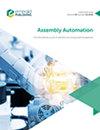家用电器行业自动装配的创造性重新设计
IF 1.7
4区 计算机科学
Q3 AUTOMATION & CONTROL SYSTEMS
引用次数: 0
摘要
目的在需要适应机器人装配的装配部件的重新设计过程中,设计师可以从结构化的创新方法中找到支持,例如创造性问题解决理论(TRIZ)。本文旨在说明作者重新设计燃气灶部件以适应机器人装配的方法。设计/方法论/方法为适应机器人装配而对任何类型的装配组件进行重新设计的设计师必须首先考虑现有机器人装配系统的特点和局限性;产生最符合需求的新设计思想可能是一项极具挑战性的任务。在这里,TRIZ方法已被证明可用于产生设计思想和找到最佳解决方案。发现作者的方法论解决了机器人装配自适应的重新设计任务的挑战,该方法利用了自动和机器人装配系统的知识以及TRIZ方法进行创新;它已被证明在燃气灶部件的重新设计、检查和原型设计中是有用的。独创性/价值本文展示了TRIZ方法如何融入重新设计过程及其对工业环境的影响。这项工作的主要价值是提供一组步骤,帮助设计者改变他们的设计组件方法,这是优化自动化使用所必需的,但尚未实现。本文章由计算机程序翻译,如有差异,请以英文原文为准。
Inventive redesign for automatic assembly in the household appliances industry
Purpose
In the redesign process of assembly components that need adaptation to robotic assembly, designers can find support from structured methodologies for innovation, such as the theory of inventive problem solving (TRIZ). This paper aims to illustrate the authors’ methodology for redesigning gas hobs components for adaptation to robotic assembly.
Design/methodology/approach
A designer approaching a redesign task of an assembly component of any kind for adaptation to robotic assembly must consider, first of all, the features and limitations of existing robotic assembly systems; the generation of new design ideas that best fit the requirements may result to be a very challenging task. Here, the TRIZ methodology has proven useful for generating design ideas and finding the best solution.
Findings
The authors’ methodology approaches the challenges of redesign tasks for robotic assembly adaptation, which exploits knowledge of automatic and robotic assembly systems and the TRIZ method for innovation; it has proven useful in the redesign, checks and prototyping of gas hobs components.
Originality/value
This paper shows how the TRIZ methodology can be integrated into the redesign process and its impact on an industrial environment. The work’s main value is to provide a set of steps to help the designers change their design components approach that is necessary but not still implemented to optimize the use of the automation.
求助全文
通过发布文献求助,成功后即可免费获取论文全文。
去求助
来源期刊

Assembly Automation
工程技术-工程:制造
CiteScore
4.30
自引率
14.30%
发文量
51
审稿时长
3.3 months
期刊介绍:
Assembly Automation publishes peer reviewed research articles, technology reviews and specially commissioned case studies. Each issue includes high quality content covering all aspects of assembly technology and automation, and reflecting the most interesting and strategically important research and development activities from around the world. Because of this, readers can stay at the very forefront of industry developments.
All research articles undergo rigorous double-blind peer review, and the journal’s policy of not publishing work that has only been tested in simulation means that only the very best and most practical research articles are included. This ensures that the material that is published has real relevance and value for commercial manufacturing and research organizations.
 求助内容:
求助内容: 应助结果提醒方式:
应助结果提醒方式:


